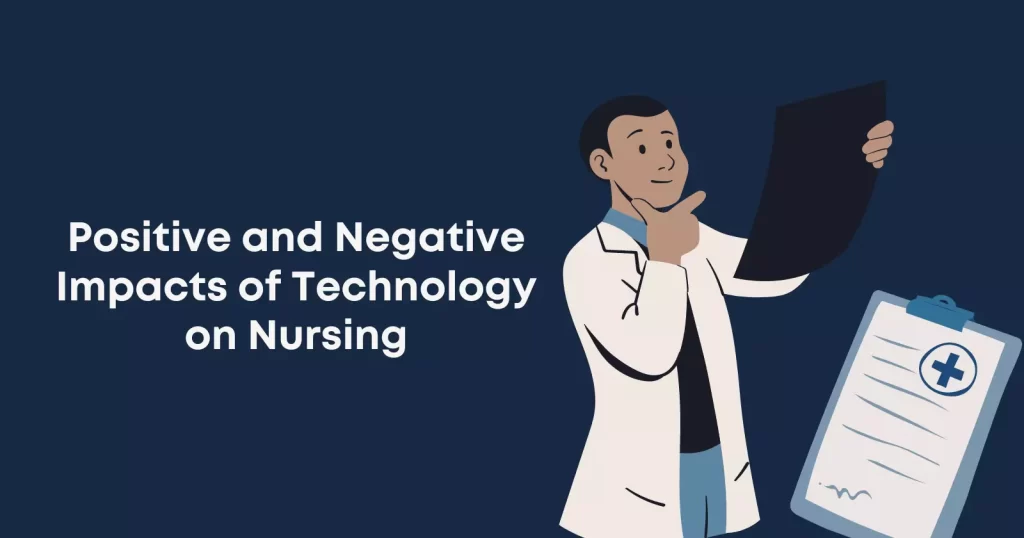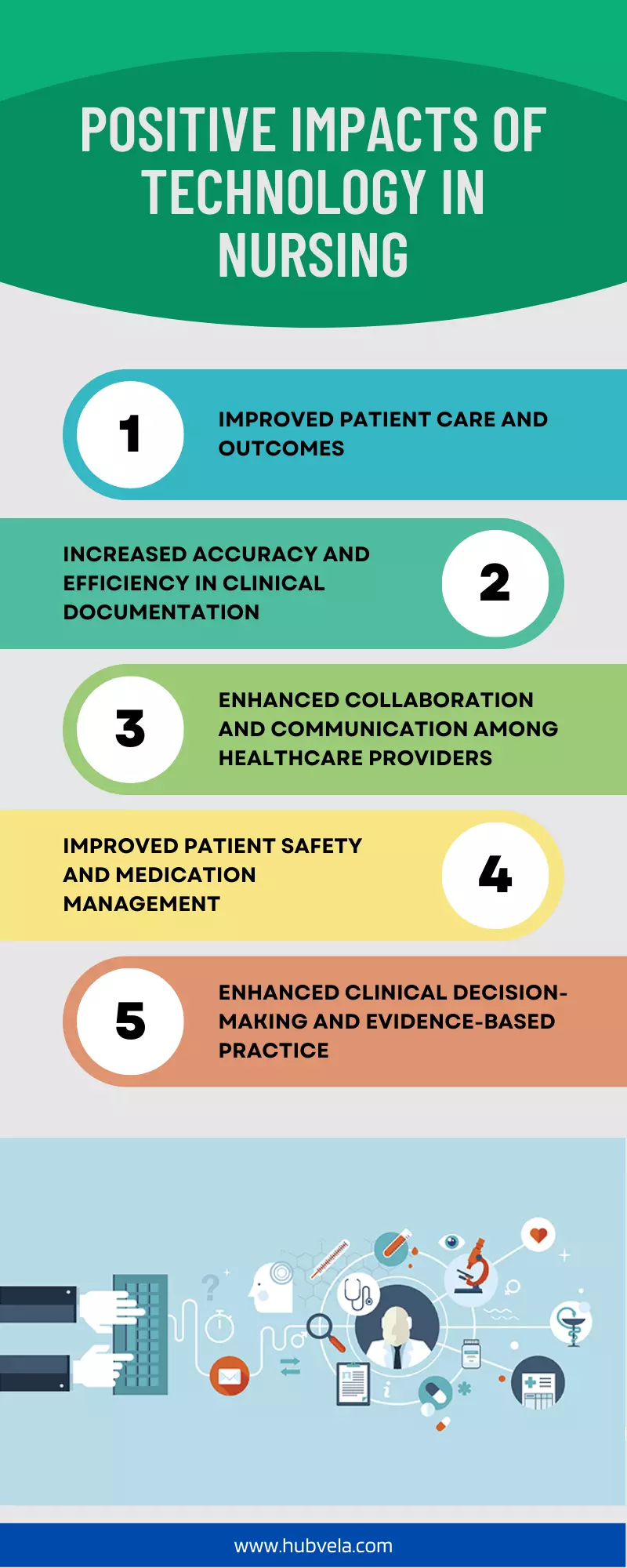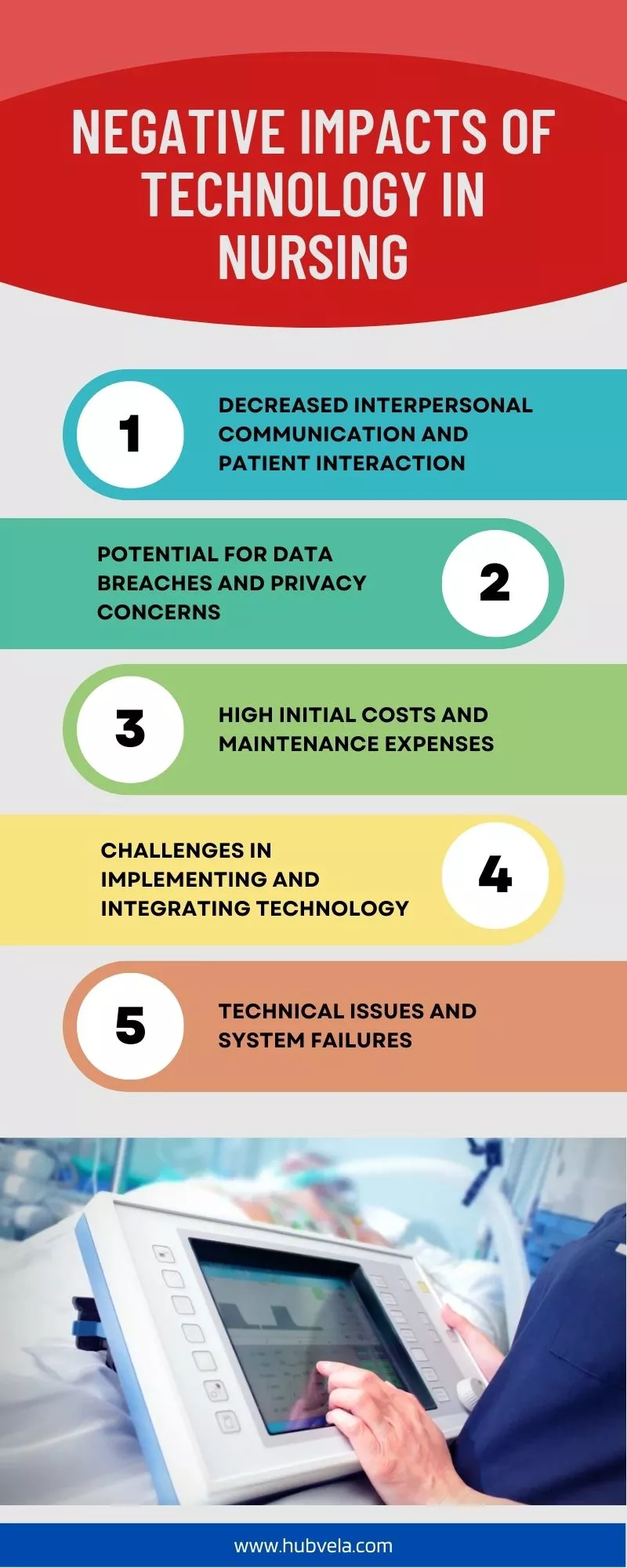Technology has revolutionized the healthcare industry, and nursing is no exception. From electronic health records to telehealth, technology has brought about significant changes in the way nurses provide care to their patients.
While these advancements have undoubtedly improved patient outcomes and made nursing more efficient, they have also brought about some negative impacts.
In this article, we will explore both the positive and negative impacts of technology on nursing.

--Advertisement--
Positive Impacts of Technology on Nursing
Technology has revolutionized the healthcare industry, and nursing is no exception. From predictive analytics to IoT-enabled systems, technological innovations have brought about significant improvements in patient care.
As we move towards a digital future, it is essential for the nursing profession to adapt and maximize the benefits of these advancements.
We will explore some of the major positive impacts of technology on nursing.

1. Improved Patient Care and Outcomes
The positive impacts of technology on nursing are evident in improved patient care and outcomes.
Emerging technologies are enabling the nursing profession to achieve the Quadruple Aim, which includes better management of populations, lower costs, and improved patient and clinician experience.
Health information technology has been shown to reduce medical errors, and adverse drug reactions, and improve compliance with practice guidelines, ultimately improving patient safety.
The implementation of patient-centered care models has also contributed to improved outcomes for patients, better use of resources, decreased costs, and increased satisfaction with care.
By improving the patient experience of care, and health outcomes, and reducing the per capita cost of healthcare, technology is playing a crucial role in achieving the Quadruple Aim.
2. Increased Accuracy and Efficiency in Clinical Documentation
Technology has brought about numerous positive impacts in nursing, including increased accuracy and efficiency in clinical documentation.
With the use of electronic health records (EHRs) and clinical documentation improvement (CDI) programs, healthcare organizations can ensure completeness and accuracy in clinical documentation, reducing treatment delays and improving the escalation of clinical deterioration.
Physicians can also benefit from CDI programs, as they can increase productivity and reduce the chance of missed opportunities for coding or documentation clarification.
Accurate clinical documentation is essential for high-quality and safe patient care, and technology has made it easier for nurses to fulfill this professional responsibility.
3. Enhanced Collaboration and Communication among Healthcare Providers
The positive impacts of technology on nursing are numerous, and one of the most significant is the enhanced collaboration and communication among healthcare providers.
With the help of technology, healthcare providers can easily communicate with each other, share information, and work together to provide the best possible care for their patients.
Interprofessional collaboration has become firmly established as an important component within education and healthcare, and there is emerging evidence that when interprofessional healthcare teams practice collaboratively, it can enhance the delivery of person-centered care and lead to improved patient and health systems outcomes.
Effective communication in healthcare can make a life-or-death difference, and technology has made it easier for healthcare providers to share information ethically and responsibly to protect patient confidentiality.
With technology, healthcare providers can work together seamlessly, resulting in better patient outcomes and a more efficient healthcare system.
4. Improved Patient Safety and Medication Management
Health information technology has been shown to reduce medication errors, and adverse drug reactions, and improve compliance with practice guidelines, ultimately leading to better patient outcomes.
Additionally, a strong safety climate is positively associated with nurses’ safety performance, highlighting the importance of psychosocial conditions in the work environment.
Reporting medication errors is also critical in improving the medication management process, as it provides important information and resources to prevent future errors.
Communication is another key aspect of improving patient safety, and technology can facilitate this through electronic health records and other tools.
Overall, technology has the potential to greatly enhance patient safety and medication management in nursing, and it is important for healthcare providers to embrace these advancements to provide the best possible care for their patients.
5. Enhanced Clinical Decision-Making and Evidence-based Practice
The integration of technology in nursing has brought about positive impacts, one of which is enhanced clinical decision-making and evidence-based practice.
With the use of technology, nurses can access and critically appraise scientifically proven evidence to deliver quality healthcare to patients.
Clinical guidelines and rules can be easily accessed and followed, ensuring standardized practice.
External evidence can be used as the basis for decision-making in clinical practice, including choosing diagnostic tests, laboratory analysis, and imaging techniques.
Evidence-based practice is crucial in improving patient outcomes, and technology has made it easier for nurses to build their body of knowledge and implement EBP.
Overall, technology has played a significant role in improving the quality of care provided by nurses through enhanced clinical decision-making and evidence-based practice.
6. Better Access to Patient Information and Health Records
Electronic health records (EHRs) provide healthcare providers with complete and accurate information, which leads to better medical care and improved patient outcomes.
Moreover, patient access to their own EHRs has the potential to decrease healthcare provision costs and improve access to healthcare data, self-care, quality of care, and health and patient-centered outcomes.
Nursing informatics competencies align with direct patient care, quality management, coordination, management, and IT roles a nurse may hold, which further enhances the benefits of EHRs.
With increased access to information, healthcare providers can make informed decisions, provide better care, and ultimately improve patient outcomes
Negative Impacts of Technology on Nursing
Technology has revolutionized the healthcare industry, including the nursing profession. While it has brought many benefits such as faster communication, efficient charting, and increased patient safety, it has also brought negative impacts.
The physical and emotional demands of nursing combined with the increasing use of technology have led to burnout and decreased job satisfaction.
Additionally, overreliance on technology can lead to errors and decreased patient interaction.
As the nursing profession continues to adapt to a digital future, it is important to consider both the pros and cons of technology in nursing.
Let’s discuss the negative impacts of technology in nursing.

1. Decreased Interpersonal Communication and Patient Interaction
The increased use of technology in nursing has led to a decrease in interpersonal communication and patient interaction.
As nurses rely more on technology, they may spend less time engaging with patients and miss important nonverbal cues.
Effective communication is essential for patient-centered care and can improve patient outcomes.
The pandemic has further highlighted the importance of communication in healthcare, and healthcare providers must prioritize communication skills to provide quality care.
Nurses must find a balance between using technology to improve patient care and maintaining meaningful patient interactions to ensure patient-centered care.
2. Potential for Data Breaches and Privacy Concerns
With the increasing amount of sensitive patient data being stored and transmitted electronically, the risk of data breaches is higher than ever before.
This can lead to the exposure of personal information, financial data, and medical records, which can be used for malicious purposes.
Additionally, the use of artificial intelligence and machine learning in healthcare can lead to privacy violations if not properly regulated.
It is important for healthcare organizations to prioritize data privacy and security to prevent such incidents from occurring.
As technology continues to advance, it is crucial to strike a balance between innovation and privacy protection to ensure the safety and well-being of patients.
3. High Initial Costs and Maintenance Expenses
The integration of technology in nursing has brought about numerous benefits, including improved patient outcomes and increased efficiency.
However, it is important to acknowledge the negative impacts that come with it, such as high initial costs and maintenance expenses.
The implementation of technology in healthcare requires significant investment, which can be a challenge for healthcare organizations with limited budgets.
Additionally, the maintenance of technology can be costly, requiring specialized personnel and regular updates to ensure optimal performance.
These expenses can be a burden on healthcare organizations, potentially limiting their ability to provide quality care to patients.
Therefore, it is crucial to carefully consider the costs and benefits of implementing technology in nursing to ensure that it is a sustainable and effective solution.
4. Challenges in Implementing and Integrating Technology
Technology has also presented several challenges that need to be addressed. One of the major challenges is the negative impact of technology on the quality of care provided to patients.
Nurses may become too reliant on technology, leading to a decrease in critical thinking and decision-making skills.
Additionally, technology misuse and breakage can lead to disruptions in patient care.
Another challenge is the amount of time and effort required to integrate technology into nursing practice.
This requires additional training and planning, which can be time-consuming and demanding.
To overcome these challenges, nurses need to be adequately trained on the use of technology and provided with ongoing support to ensure its effective integration into their practice.
5. Technical Issues and System Failures
The use of technology in nursing has undoubtedly brought about numerous benefits, but it also comes with its fair share of negative impacts.
One of the most significant issues is the occurrence of technical issues and system failures.
As nurses become more reliant on technology, they become more susceptible to bugs and system failures.
When such issues arise, they can cause significant delays and disruptions in patient care, leading to frustration and dissatisfaction among patients and healthcare providers alike.
To mitigate the negative impacts of technology in nursing, it is crucial to have a plan in place to communicate with impacted customers during a system outage.
Empathy and clear communication are key to managing the situation and minimizing the impact on patient care.
Additionally, it is essential to provide adequate training and support to nurses to ensure they can troubleshoot problems and use technology effectively.
Ultimately, preventing software from failing requires a collective effort from technical architects, industry leaders, and policymakers.
By prioritizing digital resiliency and investing in robust systems and infrastructure, we can minimize the negative impacts of technology in nursing and ensure that patients receive the care they need without disruption.
6. Inadequate Training and Lack of Technical Skills among Nurses
The negative impacts of technology in nursing are not limited to the shortage of nurses but also extend to inadequate training and lack of technical skills among nurses.
Nurses are the key professionals in the introduction, implementation, and use of technology in clinical practice.
However, a lack of technical expertise and technological understanding poses a challenge to the quality of health services and possibly to the safety, dignity, and quality of life of patients.
This is why it is important to train nurses on electronic health record (EHR) systems in a simulated environment to promote their confidence in the skills they need to grow and address the fear of mistakes and failure associated with the use of technology.
A new study has revealed that nurses report a lack of competency in using evidence-based practice (EBP).
This highlights the need for ongoing training and education to ensure that nurses have the necessary technical skills to provide high-quality care in the digital age.
Conclusion on the Positive and Negative Impacts of Technology on Nursing
In conclusion, technology has brought both positive and negative impacts on nursing. On the positive side, technology has improved patient care, increased efficiency, and provided better access to information.
Nurses can now use technology to monitor patients remotely, access electronic health records, and communicate with other healthcare professionals.
However, technology has also brought negative impacts such as the potential for errors, loss of personal touch, and the need for constant training and updates.
It is important for nurses to strike a balance between the use of technology and the human touch in providing care.
As technology continues to advance, it is crucial for nurses to adapt and embrace these changes while keeping the patient’s well-being at the forefront.


